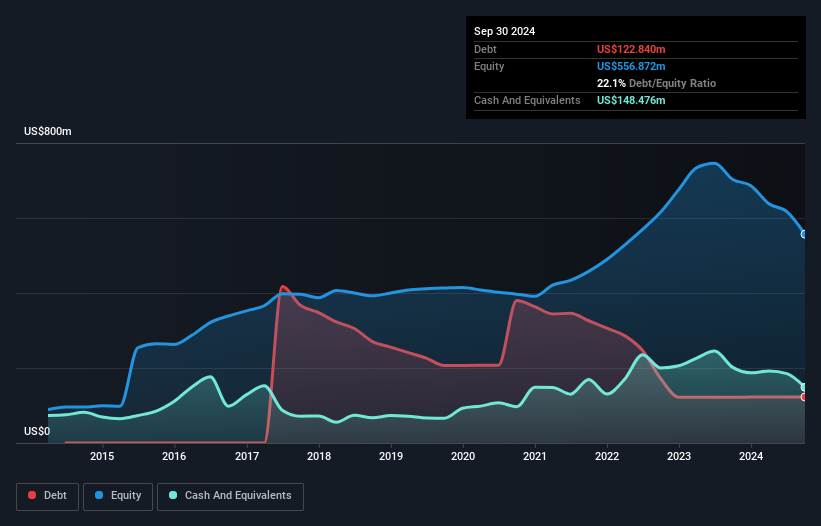Howard Marks put it nicely when he said that, rather than worrying about share price volatility, 'The possibility of permanent loss is the risk I worry about... and every practical investor I know worries about.' When we think about how risky a company is, we always like to look at its use of debt, since debt overload can lead to ruin. As with many other companies MaxLinear, Inc. (NASDAQ:MXL) makes use of debt. But the real question is whether this debt is making the company risky.
When Is Debt A Problem?
Debt assists a business until the business has trouble paying it off, either with new capital or with free cash flow. In the worst case scenario, a company can go bankrupt if it cannot pay its creditors. However, a more usual (but still expensive) situation is where a company must dilute shareholders at a cheap share price simply to get debt under control. Of course, debt can be an important tool in businesses, particularly capital heavy businesses. The first thing to do when considering how much debt a business uses is to look at its cash and debt together.
Check out our latest analysis for MaxLinear
What Is MaxLinear's Net Debt?
As you can see below, MaxLinear had US$122.8m of debt, at September 2024, which is about the same as the year before. You can click the chart for greater detail. But on the other hand it also has US$148.5m in cash, leading to a US$25.6m net cash position.

How Healthy Is MaxLinear's Balance Sheet?
We can see from the most recent balance sheet that MaxLinear had liabilities of US$168.6m falling due within a year, and liabilities of US$169.8m due beyond that. Offsetting this, it had US$148.5m in cash and US$47.9m in receivables that were due within 12 months. So it has liabilities totalling US$142.0m more than its cash and near-term receivables, combined.
Of course, MaxLinear has a market capitalization of US$1.67b, so these liabilities are probably manageable. But there are sufficient liabilities that we would certainly recommend shareholders continue to monitor the balance sheet, going forward. While it does have liabilities worth noting, MaxLinear also has more cash than debt, so we're pretty confident it can manage its debt safely. When analysing debt levels, the balance sheet is the obvious place to start. But ultimately the future profitability of the business will decide if MaxLinear can strengthen its balance sheet over time. So if you want to see what the professionals think, you might find this free report on analyst profit forecasts to be interesting.
Over 12 months, MaxLinear made a loss at the EBIT level, and saw its revenue drop to US$394m, which is a fall of 54%. That makes us nervous, to say the least.
So How Risky Is MaxLinear?
Statistically speaking companies that lose money are riskier than those that make money. And the fact is that over the last twelve months MaxLinear lost money at the earnings before interest and tax (EBIT) line. And over the same period it saw negative free cash outflow of US$56m and booked a US$226m accounting loss. But the saving grace is the US$25.6m on the balance sheet. That kitty means the company can keep spending for growth for at least two years, at current rates. Overall, we'd say the stock is a bit risky, and we're usually very cautious until we see positive free cash flow. There's no doubt that we learn most about debt from the balance sheet. However, not all investment risk resides within the balance sheet - far from it. For instance, we've identified 2 warning signs for MaxLinear that you should be aware of.
Of course, if you're the type of investor who prefers buying stocks without the burden of debt, then don't hesitate to discover our exclusive list of net cash growth stocks, today.
New: Manage All Your Stock Portfolios in One Place
We've created the ultimate portfolio companion for stock investors, and it's free.
• Connect an unlimited number of Portfolios and see your total in one currency
• Be alerted to new Warning Signs or Risks via email or mobile
• Track the Fair Value of your stocks
Have feedback on this article? Concerned about the content? Get in touch with us directly. Alternatively, email editorial-team (at) simplywallst.com.
This article by Simply Wall St is general in nature. We provide commentary based on historical data and analyst forecasts only using an unbiased methodology and our articles are not intended to be financial advice. It does not constitute a recommendation to buy or sell any stock, and does not take account of your objectives, or your financial situation. We aim to bring you long-term focused analysis driven by fundamental data. Note that our analysis may not factor in the latest price-sensitive company announcements or qualitative material. Simply Wall St has no position in any stocks mentioned.
About NasdaqGS:MXL
MaxLinear
Provides communications systems-on-chip solutions in the United States, Asia, Europe, and internationally.
Undervalued with excellent balance sheet.
Similar Companies
Market Insights
Community Narratives


Recently Updated Narratives


Alphabet: The Under-appreciated Compounder Hiding in Plain Sight


MINISO's fair value is projected at 26.69 with an anticipated PE ratio shift of 20x


The Quiet Giant That Became AI’s Power Grid
Popular Narratives


The company that turned a verb into a global necessity and basically runs the modern internet, digital ads, smartphones, maps, and AI.


MicroVision will explode future revenue by 380.37% with a vision towards success



